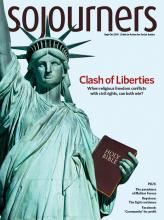AS A TEENAGER growing up in a church setting that discouraged engaging with movies, books, or music deemed a “bad influence,” I remember frequently being confused about pop culture, particularly when it came to what films I was “allowed” to watch. Was I wrong for wanting to see Taxi Driver ? For identifying with Saved? Was it a sin to watch The Last Temptation of Christ?
The answer to all these questions, of course, is “no,” but the sentiment behind them is understandable. The easiest metric for Christians to judge a film’s quality is the measure of its “objectionable” content, regardless of what that content says about the filmmaker’s intent, or the political or cultural attitudes under which it was conceived. The truth, however, is that all art—whether spiritual or secular in origin—has something to express about the world: joy in its beauty, anger at its injustice, a whole spectrum of emotions and ideas that reflect the human experience.
Read the Full Article

